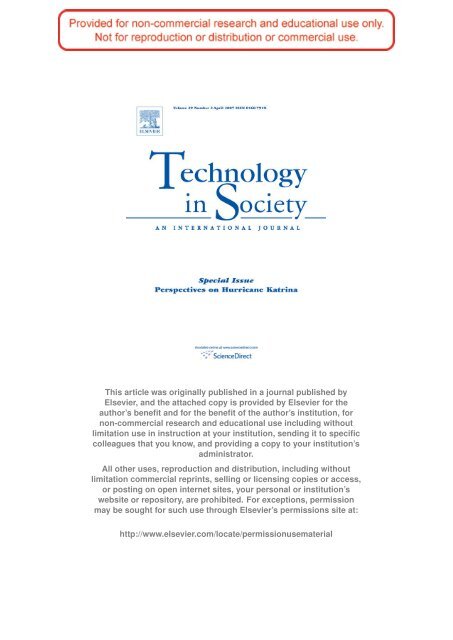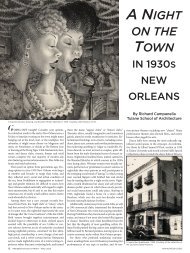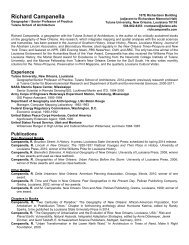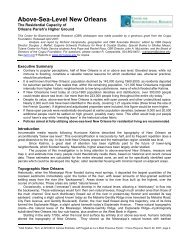Geography, Philosophy, and the Build/No-Build Line - Richard ...
Geography, Philosophy, and the Build/No-Build Line - Richard ...
Geography, Philosophy, and the Build/No-Build Line - Richard ...
You also want an ePaper? Increase the reach of your titles
YUMPU automatically turns print PDFs into web optimized ePapers that Google loves.
This article was originally published in a journal published by<br />
Elsevier, <strong>and</strong> <strong>the</strong> attached copy is provided by Elsevier for <strong>the</strong><br />
author’s benefit <strong>and</strong> for <strong>the</strong> benefit of <strong>the</strong> author’s institution, for<br />
non-commercial research <strong>and</strong> educational use including without<br />
limitation use in instruction at your institution, sending it to specific<br />
colleagues that you know, <strong>and</strong> providing a copy to your institution’s<br />
administrator.<br />
All o<strong>the</strong>r uses, reproduction <strong>and</strong> distribution, including without<br />
limitation commercial reprints, selling or licensing copies or access,<br />
or posting on open internet sites, your personal or institution’s<br />
website or repository, are prohibited. For exceptions, permission<br />
may be sought for such use through Elsevier’s permissions site at:<br />
http://www.elsevier.com/locate/permissionusematerial
ARTICLE IN PRESS<br />
Technology in Society 29 (2007) 169–172<br />
www.elsevier.com/locate/techsoc<br />
Abstract<br />
<strong>Geography</strong>, philosophy, <strong>and</strong> <strong>the</strong> build/no-build line<br />
<strong>Richard</strong> Campanella <br />
Tulane University, New Orleans, Louisiana<br />
Deeply rooted values <strong>and</strong> perceptions regarding technology, society, place, <strong>and</strong> <strong>the</strong> environment inform <strong>the</strong> passionate<br />
debate about <strong>the</strong> future of New Orleans. This article describes three overriding rebuilding philosophies, <strong>and</strong> <strong>the</strong>ir<br />
geographical implications, that have emerged from that public discourse in <strong>the</strong> year following Hurricane Katrina.<br />
It concludes with a commentary on embracing social, cultural, <strong>and</strong> humanistic values even when <strong>the</strong> problem at h<strong>and</strong><br />
appears to be one of science, engineering, <strong>and</strong> technology.<br />
r 2007 Elsevier Ltd. All rights reserved.<br />
Keywords: New Orleans; Louisiana; Hurricane Katrina; Coastal erosion; Catastrophe; Disaster; Recovery<br />
1. Introduction<br />
Various philosophies have emerged on <strong>the</strong> rebuilding of New Orleans, each with its own logic, passion,<br />
experts, <strong>and</strong> dogma. But all can be boiled down to a simple line on a map, separating areas recommended for<br />
rebuilding from those deemed best returned to nature. Where people locate <strong>the</strong>ir build/no-build line says as<br />
much about <strong>the</strong>m—<strong>and</strong> how <strong>the</strong>y view <strong>and</strong> weigh science, economics, social, <strong>and</strong> humanistic values—as it says<br />
about <strong>the</strong> geographical future of New Orleans.<br />
One philosophy recommends <strong>the</strong> total ab<strong>and</strong>onment of <strong>the</strong> metropolis. Its advocates essentially draw <strong>the</strong><br />
build/no-build line at <strong>the</strong> metropolis’ upper boundary, somewhere between rural St. Charles Parish <strong>and</strong><br />
urbanized Jefferson Parish, or above Lake Pontchartrain’s nor<strong>the</strong>rn shore. St. Louis University geologist<br />
Timothy M. Kusky first voiced <strong>the</strong> ‘‘ab<strong>and</strong>onist’’ philosophy in a Boston Globe editorial, which later earned<br />
him a national audience on <strong>the</strong> popular US television show 60 minutes. He readily acknowledged:<br />
New Orleans is one of America’s great historic cities, <strong>and</strong> our emotional response to <strong>the</strong> disaster is to rebuild<br />
it gr<strong>and</strong>er <strong>and</strong> greater than before. However, this may not be <strong>the</strong> most rational or scientifically sound<br />
response <strong>and</strong> could lead to even greater human catastrophe <strong>and</strong> financial loss in <strong>the</strong> future [1].<br />
Ab<strong>and</strong>onists like Kusky tend to be pragmatic <strong>and</strong> fiscally conservative; for <strong>the</strong>m it is a rational<br />
question of hard science, hard dollars, <strong>and</strong> body counts. In making <strong>the</strong>ir case, <strong>the</strong>y cite only <strong>the</strong><br />
gloomiest scientific data on subsidence, coastal erosion, <strong>and</strong> sea-level rise, <strong>and</strong> dismiss humanist <strong>and</strong> cultural<br />
Author's personal copy<br />
Tel.: +1 504 862 8453; fax: +1 504 862 8455.<br />
E-mail address: rcampane@tulane.edu.<br />
0160-791X/$ - see front matter r 2007 Elsevier Ltd. All rights reserved.<br />
doi:10.1016/j.techsoc.2007.01.005
170<br />
ARTICLE IN PRESS<br />
R. Campanella / Technology in Society 29 (2007) 169–172<br />
arguments as ‘‘emotional’’ or ‘‘nostalgic.’’ Ab<strong>and</strong>onists almost always have nothing to lose personally<br />
if <strong>the</strong> city does disappear. They are loa<strong>the</strong>d in New Orleans, but occupy a seat at <strong>the</strong> table in <strong>the</strong> national<br />
discourse.<br />
At <strong>the</strong> opposite end are those who advocate maintaining <strong>the</strong> urban footprint at all costs. Unlike<br />
ab<strong>and</strong>onists, ‘‘maintainers’’ see this as primarily a humanist <strong>and</strong> cultural question, ra<strong>the</strong>r than a scientific or<br />
engineering one. To be against maintaining all neighborhoods is to be against people <strong>and</strong> against culture—<br />
worse yet, against certain people <strong>and</strong> certain cultures. Maintainers tend to be passionate, oftentimes angry,<br />
<strong>and</strong> for good reason: many are flood victims <strong>and</strong> have everything to lose if <strong>the</strong> build/no-build line crosses <strong>the</strong>ir<br />
homes. If a levee can be built well enough to protect <strong>the</strong>m, <strong>the</strong>y reason, why not extend it around us? Among<br />
<strong>the</strong> most outspoken maintainers are social activists who interpret any post-diluvian adjustment to <strong>the</strong> urban<br />
perimeter as a conspiracy of ‘‘politically conservative, economically neoliberal power elites’’ who ‘‘are doing<br />
everything in <strong>the</strong>ir power to prevent [working-class African-Americans] from returning’’ [2]. Ignoring scientific<br />
data <strong>and</strong> fiscal constraints, maintainers push <strong>the</strong> build/no-build line beyond <strong>the</strong> rural fringes of St. Bernard<br />
Parish, even all <strong>the</strong> way to <strong>the</strong> Gulf of Mexico.<br />
In between are <strong>the</strong> ‘‘concessionists,’’ usually aficionados of <strong>the</strong> city, particularly its historical heart, <strong>and</strong><br />
often residents of its unflooded sections. Concessionists struggle to balance troubling scientific data with<br />
treasured social <strong>and</strong> cultural resources. Their answer: concede certain low-lying modern subdivisions to<br />
nature—areas which, incidentally, <strong>the</strong>y never found structurally appealing in <strong>the</strong> first place—<strong>and</strong> increase<br />
population density <strong>and</strong> flood protection in <strong>the</strong> higher, historically significant areas.<br />
Sensitive to accusations of insensitivity, concessionists soften <strong>the</strong>ir message with careful wordsmithing <strong>and</strong><br />
confusing maps. The Urban L<strong>and</strong> Institute (ULI), which advised <strong>the</strong> city on rebuilding options in <strong>No</strong>vember<br />
2005, delineated three innocuous-sounding ‘‘investment zones’’ <strong>and</strong> cartographically depicted <strong>the</strong>m in barely<br />
distinguishable shades of lavender. One had to read <strong>the</strong> report very carefully to underst<strong>and</strong> that, in fact,<br />
‘‘investment zone A,’’ despite its optimistic name, was recommended for substantial conversion to green space<br />
<strong>and</strong>, at best, delayed rebuilding [3]. In January 2006, <strong>the</strong> Bring New Orleans Back (BNOB) Commission map<br />
echoed a similar concessionist sentiment, euphemistically labeling flooded areas with questionable futures as<br />
‘‘neighborhood planning areas,’’ while unflooded zones with rosy outlooks were called ‘‘immediate<br />
opportunity areas’’ [4]. Maintainers angrily denounced both <strong>the</strong> ULI’s <strong>and</strong> BNOB Commission’s concessionist<br />
philosophies at every public hearing <strong>and</strong> in no uncertain terms.<br />
Concessionists place <strong>the</strong>ir build/no-build line somewhere between those of <strong>the</strong> ab<strong>and</strong>onists <strong>and</strong> <strong>the</strong><br />
maintainers—sometimes near <strong>the</strong> Industrial Canal, sometimes between <strong>the</strong> Metairie/Gentilly Ridge <strong>and</strong> <strong>the</strong><br />
lakefront, usually to <strong>the</strong> exclusion of <strong>the</strong> distant, charmless, low-lying suburbs known as New Orleans East.<br />
Concessionists enjoy widespread support among many educated professionals who live on high ground, but<br />
encounter fierce resistance among maintainers. One resident of a neighborhood slated for possible concession<br />
declared to <strong>the</strong> chair of <strong>the</strong> BNOB Commission (who happens to be a major real estate developer), ‘‘Mr. Joe<br />
Canizaro, I do not know you, but I hate you. You have been in <strong>the</strong> background trying to scheme to get our<br />
l<strong>and</strong>!’’ [5].<br />
Recent news that rural, isolated lower Plaquemines Parish—home to only 14,000 people, or 2% of <strong>the</strong><br />
region’s population—may not receive <strong>the</strong> $1.6 billion needed for levee repair [6] might spawn a fourth<br />
philosophy: push <strong>the</strong> build/no-build line down just past Belle Chasse, <strong>the</strong> only major community in upper<br />
Plaquemines Parish that adjoins <strong>the</strong> metropolitan area. Advocates might include city dwellers, both<br />
concessionists <strong>and</strong> maintainers, who st<strong>and</strong> to benefit from <strong>the</strong> ab<strong>and</strong>onment of lower Plaquemines because it<br />
would clear <strong>the</strong> path for aggressive coastal restoration while reducing <strong>the</strong> price tag on <strong>the</strong>ir own protection.<br />
Let <strong>the</strong> sediment-laden waters of <strong>the</strong> Mississippi River replenish those eroding marshes, <strong>the</strong>y might contend;<br />
we need to restore <strong>the</strong>m to buffer <strong>the</strong> metropolis against storm surges. What about <strong>the</strong> rural peoples who have<br />
called those marshes home for over a century? Well, as geologist Kusky put it in his now-famous ab<strong>and</strong>onist<br />
editorial, it’s ‘‘time to move to higher ground’’ [1]. (Fig. 1)<br />
Thus, social, cultural, <strong>and</strong> humanistic values, plus a sense of personal investment, tend to push <strong>the</strong> build/nobuild<br />
line in a downriver direction, while scientific <strong>and</strong> financial values nudge <strong>the</strong> line upriver. What to make<br />
of all this?<br />
First, even <strong>the</strong> most ardent lovers of New Orleans should refrain from loathing <strong>the</strong> ab<strong>and</strong>onists. After all,<br />
concessionists (<strong>and</strong> those maintainers willing to sacrifice lower Plaquemines) are essentially making <strong>the</strong> same<br />
Author's personal copy
ARTICLE IN PRESS<br />
R. Campanella / Technology in Society 29 (2007) 169–172 171<br />
Fig. 1. Possible build/no-build lines in post-Katrina New Orleans.<br />
ab<strong>and</strong>onist arguments that earned Kusky <strong>the</strong> enduring hatred of many New Orleanians. They are just<br />
applying <strong>the</strong>m below different lines on <strong>the</strong> map.<br />
Second, we should probably only pencil in whatever build/no-build line we draw, because we may well wish<br />
to change it if <strong>the</strong> going gets rough. O<strong>the</strong>rs have. Illinois Republican Rep. J. Dennis Hastert was among <strong>the</strong><br />
first to hint at ab<strong>and</strong>onment when he said rebuilding New Orleans ‘‘does not make sense to me. And it is a<br />
question that certainly we should ask.’’ Shaken by angry responses, he later clarified his statement: ‘‘I am not<br />
advocating that <strong>the</strong> city be ab<strong>and</strong>oned or relocatedy’’ [7]. Wallace, Roberts <strong>and</strong> Todd, a design firm hired to<br />
advise <strong>the</strong> BNOB Commission, at first professed a bold maintainer philosophy (‘‘if you plan on shrinkage,<br />
shrinkage is what you will get’’ [8]) but ended up recommending concessions in <strong>the</strong>ir final report to <strong>the</strong><br />
Commission. Even Kusky softened his ab<strong>and</strong>onist advice <strong>and</strong> suggested <strong>the</strong> possibility of ‘‘newer, higher,<br />
stronger seawalls’’ for ‘‘<strong>the</strong> business <strong>and</strong> historic parts of <strong>the</strong> city’’ [1].<br />
I, too, as a geographer with both physical <strong>and</strong> cultural interests, have grappled with my concessionist<br />
recommendations when confronted by <strong>the</strong> tragic personal stories of individuals who desperately want to<br />
maintain <strong>the</strong> world <strong>the</strong>y once knew <strong>and</strong> loved. Should ano<strong>the</strong>r hurricane of <strong>the</strong> magnitude of Katrina strike<br />
New Orleans, we might see build/no-build lines erased <strong>and</strong> redrawn en masse: maintainers may become<br />
concessionists, concessionists may be willing to concede more, <strong>and</strong> ab<strong>and</strong>onists will increase <strong>the</strong>ir ranks.<br />
Finally, beware of those who claim to speak solely ‘‘for science,’’ or ‘‘for <strong>the</strong> people.’’ This is a complicated,<br />
interdisciplinary problem. The social scientist needs to be at <strong>the</strong> table as much as <strong>the</strong> physical scientist; <strong>the</strong><br />
humanist deserves a voice as much as <strong>the</strong> economist; <strong>the</strong> poor renter of a shotgun house should be heard as<br />
much as <strong>the</strong> rich owner of a mansion. We should acknowledge that a tangle of personal, cultural, financial,<br />
Author's personal copy
172<br />
ARTICLE IN PRESS<br />
R. Campanella / Technology in Society 29 (2007) 169–172<br />
nostalgic, emotional, practical, <strong>and</strong> scientific factors underlie which philosophy—ab<strong>and</strong>on, maintain, or<br />
concede—we uphold for <strong>the</strong> future of New Orleans, <strong>and</strong> that this is OK; this is acceptable.<br />
References<br />
[1] Kusky TM. Time to move to higher ground. Boston Globe 25 September 2005: D12 (emphasis added).<br />
[2] Arena J. As quoted by Gustavo Capdevila. World Economic Forum: Davos <strong>and</strong> New Orleans, neoliberal twins. Inter Press Service<br />
News Agency, 30 January 2006. /http://ipsnews.net/news.asp?idnews=31964S. Accessed 5/26/06.<br />
[3] Urban L<strong>and</strong> Institute. New Orleans, Louisiana: a strategy for rebuilding—an advisory services program report, <strong>No</strong>vember 12–18,<br />
2005. Map, p. 45 of PowerPoint file.<br />
[4] Bring New Orleans Back Commission. Action plan for New Orleans: <strong>the</strong> new American city. January 11, 2006. Neighborhood<br />
rebuilding strategy map, p. 48 of PowerPoint file.<br />
[5] Russell G, Donze F. Rebuilding proposal gets mixed reception; critics vocal, but many prefer to watch <strong>and</strong> wait. Times-Picayune, 12<br />
January 2006:1.<br />
[6] Brown M, Nelson R. Plaquemines feels left out of recovery plan. Times-Picayune, 14 April 2006:1.<br />
[7] Treaster JB, Sontag D. Despair <strong>and</strong> lawlessness grip New Orleans as thous<strong>and</strong>s remain str<strong>and</strong>ed in squalor. New York Times, 2<br />
September 2005:1.<br />
[8] Beckman J. Oral presentation on progress of WRT Design’s investigation. New Orleans, Louisiana, December 2, 2005 (attended <strong>and</strong><br />
recorded by author).<br />
<strong>Richard</strong> Campanella, a geographer <strong>and</strong> mapping scientist, is <strong>the</strong> associate director of <strong>the</strong> Center for Bioenvironmental Research at Tulane<br />
University <strong>and</strong> a research professor in Tulane’s Department of Earth <strong>and</strong> Environmental Sciences. A resident of New Orleans’ upper<br />
Ninth Ward, Campanella is <strong>the</strong> author of three critically acclaimed books about <strong>the</strong> city’s historical geography, including <strong>the</strong> recently<br />
released Geographies of New Orleans: Urban fabrics Before <strong>the</strong> Storm (Center for Louisiana Studies, 2006).<br />
Author's personal copy





